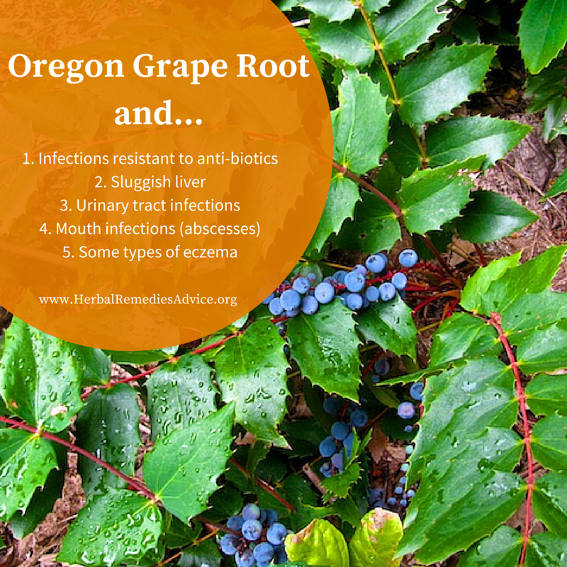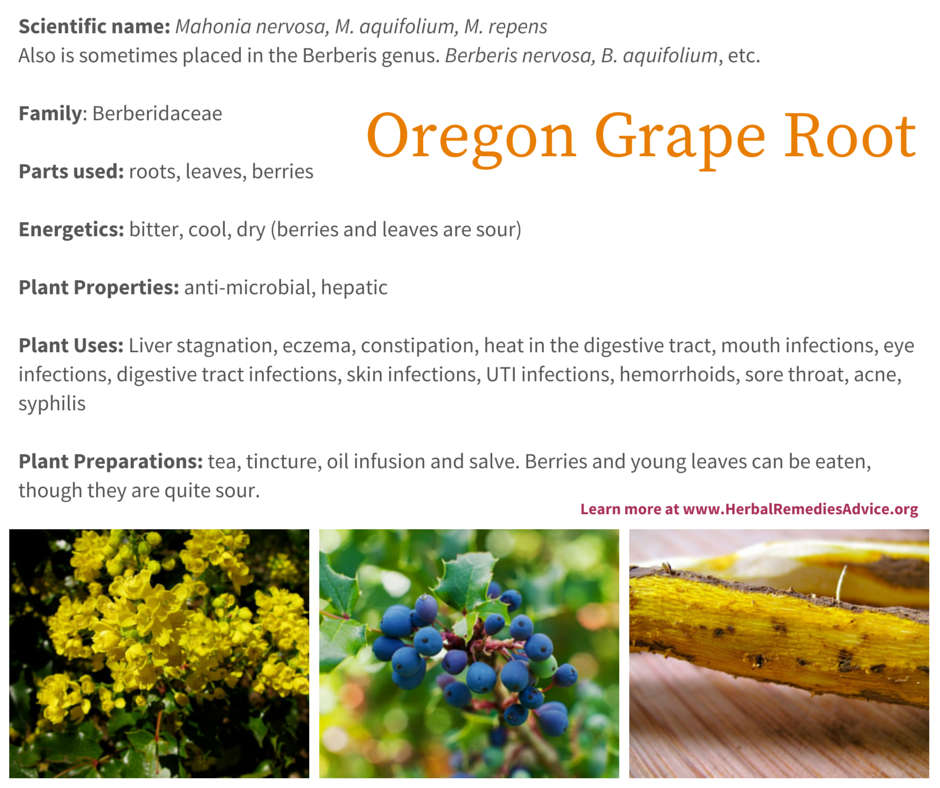Get weekly tips, recipes, and my Herbal Jumpstart e-course! Sign up for free today.

Oregon Grape Herb
Share this! |
|
Oregon grape herb is strong and fairly specific medicine. While some herbs are polycrest herbs, meaning they can be used for a wide range of ailments, Oregon Grape Root is more specific in its actions.
Oregon grape root does two things really well. It addresses infection and it acts on the liver. And, because there are a myriad of problems caused by the liver, Oregon Grape Root is far reaching.
In this monograph we’ll be looking at Oregon Grape Herb and its ability to fight infection as well as its affinity for the liver.
A Powerful Anti-microbial in Modern Times
Oregon Grape Root could save the world.
It’s no exaggeration!
Have you heard of Methicillin-resistant Staphylococcus aureus? This mouthful, also commonly called MRSA, is a serious staph infection in humans that is resistant to pharmaceutical antibiotics.
About 5,500 people die each year in the US due to a MRSA infection. Over two-thirds of the people who contract MRSA can relate it to a hospital visit. MRSA is very serious!
That is where Oregon Grape Herb comes in. A constituent of Oregon Grape Root, berberine, is being studied because it contains a specific multidrug resistance pump inhibitor (MDR Inhibitor) named 5′-methoxyhydnocarpin (5′-MHC).
I know that sounds intimidating.
Basically, what this means is that it works to decrease bacterial resistance to antibiotics. A simplified view of how MRSA works in the body is that it has a pump in its cell and when antibiotics enter that cell the pump immediately pumps out the antibiotics so it can have no effect on the MRSA cell.
5′-MHC, which is derived from berberine-containing plants like Oregon grape root, stops that pumping action so the antibiotics can have an effect on the MRSA cell.
Some herbalists are using Oregon grape herb alongside antibiotics to increase their effectiveness against this deadly infection.
Of course drug companies are racing to patent this as a pharmaceutical drug.
Okay, maybe Oregon grape root isn’t necessarily going to save the world. But that it can be used to address this very serious and deadly infection is powerful news!
Stermitz
et al, in Proceedings of the National Academy of Sciences 2000 97:4
also found the presence of 5′-methoxyhydnocarpin in the root. Although
in itself it possesses no anti-microbial activity, it strongly
potentiates the action of berberine by disabling the bacterial
resistance mechanism against both synthetic and natural antimicrobials.
The implication is immense for creating synergistic combinations to
attack the new breed of antibiotic resistant organisms.
- Robert Dale Rogers

j
Oregon Grape Root is a Strong Antimicrobial
Oregon grape root has been used to address minor to severe infections for hundreds, if not thousands of years. It was highly regarded among eclectic physicians for use against syphilis.
Berberis
aquifolium has won its reputation chiefly as a remedy for the
syphilitic taint. The more chronic the conditions or results of the
disease, the more it has been praised. Some claim that if given early it
will abort the tertiary stage, but this of course depends in most cases
upon the resisting powers of the body and the care the patient takes of
himself.
- Harvey Wickes Felter, M.D. (1922)
Today herbalists use Oregon grape herb for all kinds of infections.
- eye infections
- vaginal infections
- wounds on the skin
- mouth infections
- inflammatory bowel conditions
- infectious diarrhea (e.g., giardia and other parasites)
- infections in the upper digestive tract (h. pylori)
- urinary tract infections
- sore throats
The Energetics of Oregon Grape Herb
Seeing this long list of ways herbalists use Oregon grape herb to fight infections could seemingly give it the title of an “herbal antibiotic”. However, I find this term to be too simplified and often misleading.
We have a variety of herbs that are antimicrobials, meaning that they have some effect on pathogens. However, each one works in different ways, for different infections, and are best suited to the individual, not the disease.
To understand the complexity of each herb we can study it energetically.
Oregon grape root is bitter, bitter, bitter. I often use it when teaching people about the Taste of Herbs since it really is an archetypal bitter. I often say it is disastrously bitter.
As a bitter it is a cooling, draining and detoxifying herb. (More on detoxifying in the next section about the liver).
Because Oregon grape root cools, drains and detoxifies, it will be most effective when matched to a person who has hot, moist and possibly stagnant conditions. (Although herbalists don’t agree on the humidity factor with Matt Wood and Michael Moore saying it is more specific to dryness.)
Heat in the body is characterized by redness, inflammation, yellow secretions (or a yellow coating of the tongue) and, of course, heat. Moistness in the body is just that: weepy or infections that seep pus or leak fluids, especially fluids that are yellow.
Understanding the energetics of Oregon grape herb and the type of person and infection it is best suited to will result in getting consistent effective results.
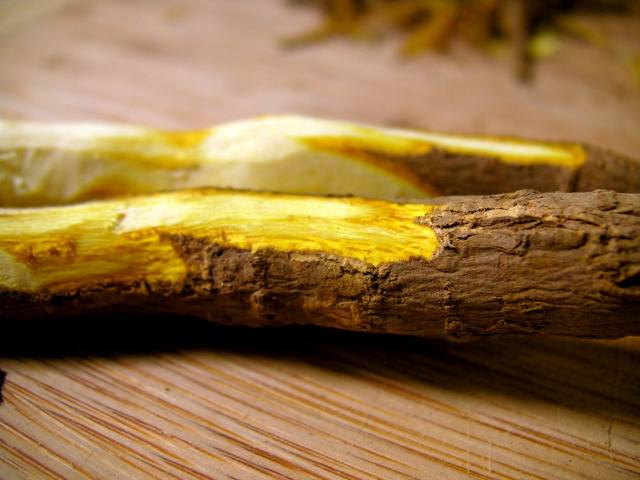 Oregon Grape Root
Oregon Grape RootBerberine
You’ll often see Oregon grape root referred to as a “berberine-containing plant”. Berberine is a chemical constituent found in several different plants that has been studied extensively. If you like to geek out on constituent studies check out the PubMed database and you’ll find studies showing berberine can lower blood glucose levels, stop infections and modulate inflammation.
Studying plants by their chemical constituents gives new insights or at least a different perspective on plants that wasn’t available to us even 200 years ago. However, it is very limiting and overly simplifying to assume that all herbs that contain berberine are used in a similar manner.
So while plants like goldenseal (Hydrastis canadensis), Barberry (Berberis vulgaris), Goldthread (Coptis trifolia), and Amur cork tree (Phellodendron amurense) all contain berberine, they aren’t necessarily used in the exact same manner. The differentiation between these plants is beyond the scope of what I can cover here.
Today
[Oregon grape root] is one of the indispensable articles of herbal
materia medica. It was first used as a bitter tonic to promote internal
and external secretion in dry and atrophic diseases. Today it is
sometimes used (or abused, really) as a “natural antibiotic” because the
presence of germ-killing-berberine. This is a materialistic way of
viewing a plant by its “active ingredient” rather than by the overall
influence of its numerous constituents working together.
- Matthew Wood, Earthwise Herbal: New World Medicinal Plants
Oregon Grape Root for the Liver
Another area in which Oregon grape root shines is as an hepatic, or as an herb for the liver.
In western herbalism most bitter herbs are considered to have some effect on the liver and the gallbladder. The bitter taste on the tongue stimulates saliva, which then creates a whole cascade of digestive functions and digestive enzymatic secretions.
Part of the bitter taste reflex is to promote the secretion of bile from the liver and the gallbladder, which helps with digestion, mainly in digesting fats.

Symptoms of a Congested Liver
Liver congestion is one of the main underlying causes of many issues I see in my clinical practice. Of course each herbal formula I give is specifically formulated for the person and the issues they are having. However, I often use a base combination of dandelion root and Oregon grape root for a wide range of liver issues. In this section we’ll look at a variety of health complaints that could potentially be solved by releasing a stagnant liver.
Seeing a list of liver congestion symptoms could easily lead one to believe that it’s a “fad” diagnosis that is vague and broad. The thing is, the liver performs many functions in the body and, therefore, correcting liver dysfunction can correct a wide range of problems! In Chinese medicine the Liver is considered to be the General of the body because it directs so many physiological functions.
The Liver and the Female Reproductive System
Because the liver filters hormones, a congested liver can be the root cause of many menstrual problems, including irregular menstruation, flooding, cramping, bloating, headaches and PMS. It can also be the underlying cause of more severe dysfunctions in the female reproductive system, such as endometriosis, ovarian cysts and fibroids. Hepatic herbs like Oregon grape root can be combined with lymphatic herbs and blood- moving herbs (and lifestyle changes) to address a variety of these complaints.
The Liver and the Skin
The liver is a main organ of elimination; when it is not functioning optimally other systems of elimination may be overwhelmed. We can clearly see this with the connection of the liver and the skin. Oftentimes a congested liver can play part of the role in things like skin rashes, eczema and psoriasis. Alterative herbs like Oregon grape root and dandelion are often used for people with these types of skin afflictions.
In moist eczema it has acted most satisfactorily, but has usually been given in conjunction with other treatment. Dr. Soper, in 1884, reported in the Therapeutic Gazette a most intractable case of moist eczema of an acute character covering the entire body. No other alterative was given. The case was cured in four weeks. - Ellingwood
The Liver and Constipation or Sluggish Digestion
When the liver isn’t functioning optimally, digestion takes a hard hit!
Inability to digest fats, bloating, gas, hemorrhoids and constipation
can all be attributed to liver problems. I often add small amounts of
Oregon grape root as part of my bitters blends to help move the liver in
the case of sluggish digestion.
The Liver and the Eyes and Head
In Traditional Chinese Medicine the liver is associated with the eyes.
Dry eyes, red eyes, excessively tearing eyes, macular degeneration, etc
can all have a base in liver function. Also, some types of headaches
are caused by poor liver function.
The Liver and the Musculoskeletal System and Energy Levels
If the liver isn’t able to filter the blood and remove toxins and metabolic wastes it can result in feeling aches and pains all over. It can also poorly effect energy levels; the liver is especially indicated when a person feels groggy upon waking.
Benefits of Oregon Grape
I realize this is a lot of physiology in a monograph, but rather than simply listing all the “diseases” that Oregon grape herb is good for, I wanted to give a more thorough explanation of how it all ties together. It’s also important to realize that it is often formulated with other herbs and lifestyle suggestions and is rarely a stand alone treatment. (Although I probably have to qualify that, as some herbalists only practice with simples.)
Energetically we still look for the same indications that we discussed in the section on infection. Heat and excess dampness are great indications. Does the person have a red tongue with a yellow coating? That’s heat. Is their pulse fast and wiry? That’s heat. Do they have eczema that is hot to the touch and weepy? That’s heat.
If someone doesn’t have heat symptoms Oregon grape herb could still be used if it were deemed appropriate through other indications. However, more attention would be paid to the formula to ensure that it was a good match for the person.
Oregon Grape Herb
In this article I've used the terms 'Oregon grape herb' and 'Oregon grape root' interchangeably because, currently, western herbalists most often use the roots as herbal medicine. But the leaves and berries have historical and modern uses as well.
Oregon Grape Leaves
Since I have no experience with using the leaves medicinally I’ll rely on Robert Dale Rogers’ historical accounts.
The
leaf tea was used for kidney and stomach ailments, as well as
rheumatism and lack of appetite. …the dried leaf is an excellent
anti-microbial styptic for herpes and psoratic skin lesions. They
contain alkaloids that act on cardiac and smooth muscle as an
anti-spasmodic. - Robert Dale Rogers
The young leaves can be eaten. And when I say young I mean it! The older leaves become very tough and quite spiky. The young tender leaves have a slightly sour taste reminiscent of a citrus fruit.
Oregon Grape Berries
The berries are edible, though perhaps not palatable. If the roots are decidedly bitter then the berries can be described as disastrously sour! Most often the berries are added to a lot of sugar before they are considered edible. Jams, pies and wines are made from the berries. The natives in my area dried them and combined them with other sweeter fruits like saskatoon berries.
There are also ethnobotanical records of the berries being used medicinally. Again I’ll rely on Robert Dale Rogers who says…
They also brewed the berries to relieve the ache of sore kidneys. When the berries turned black they were used to treat sores, or put on painful skin boils. They were crushed onto the boil and pulled off when dry and itchy. According to Duke, “California Indians used the berry decoction to stimulate the appetite”
We’ve lost so many ways of using herbs that I think it is important to include historical usage to inspire us to try these methods and re-learn what was lost.
Botanically Speaking: Berberidacea
There is a multitude of “Oregon grape” in the Mahonia or Berberis genus. For this monograph I’ll talk specifically about Mahonia aquifolium. Check your local guidebook for the identifying features of your local variety.
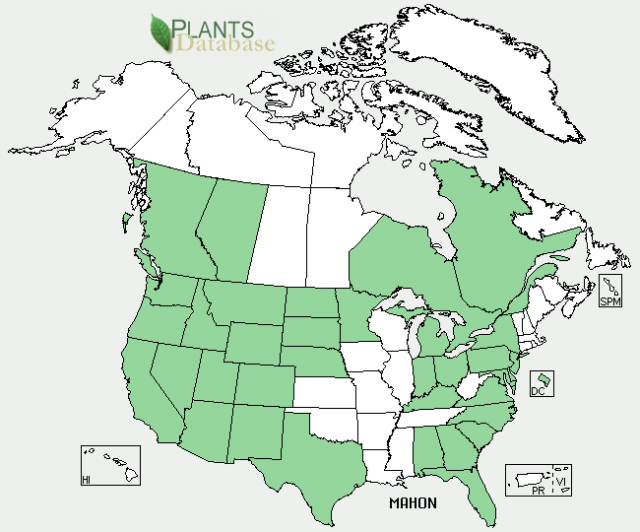 Range map of the Mahonia genus
Range map of the Mahonia genusSometimes referred to as Tall Oregon grape, Mahonia aquifolium can grow upwards of 10 feet in the right conditions. More commonly I see it around 4 – 5 feet in height.

Oregon Grape herb can spread through horizontal rhizomes, forming colonies in an area. It thrives in moist soils with sun exposure but is often found growing throughout the forest floor albeit in a shorter and less berry-filled manner.
The leaves are holly-like in appearance and are green with sharp spikes. The leaves tend to be really shiny. These are really sharp! I’ve bled from being too careless around the leaves.
Unlike holly leaves they grow as leaflets. The Mahonia species can sometimes be differentiated by how many leaflets there are. Typically Mahonia aquifolium has 5-9 leaflets.
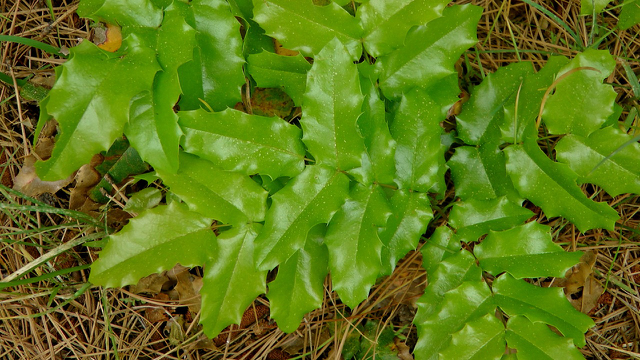
The flowers of Oregon grape herb are some of the first flowers to appear in the spring and
are yellow with parts of six. The flowers are edible, keeping in mind
that any you eat won’t turn into berries later in the season. They are
slightly sour in taste and are nice sprinkled on salads or as a garnish
with meat dishes.
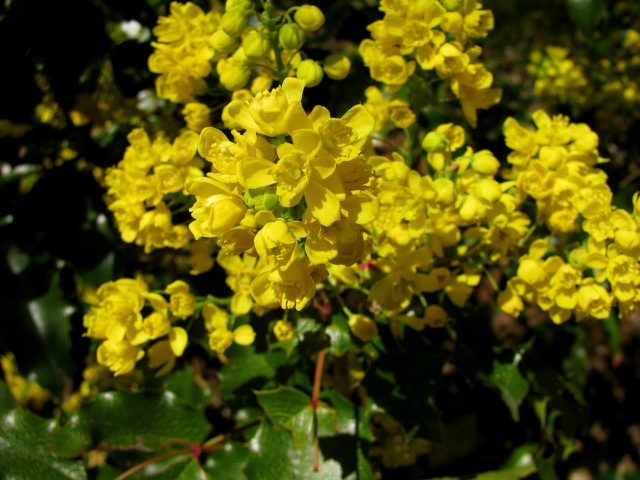
In the late summer and fall the berries can be bursting on these plants,
especially if they have access to a lot of water and sunshine.
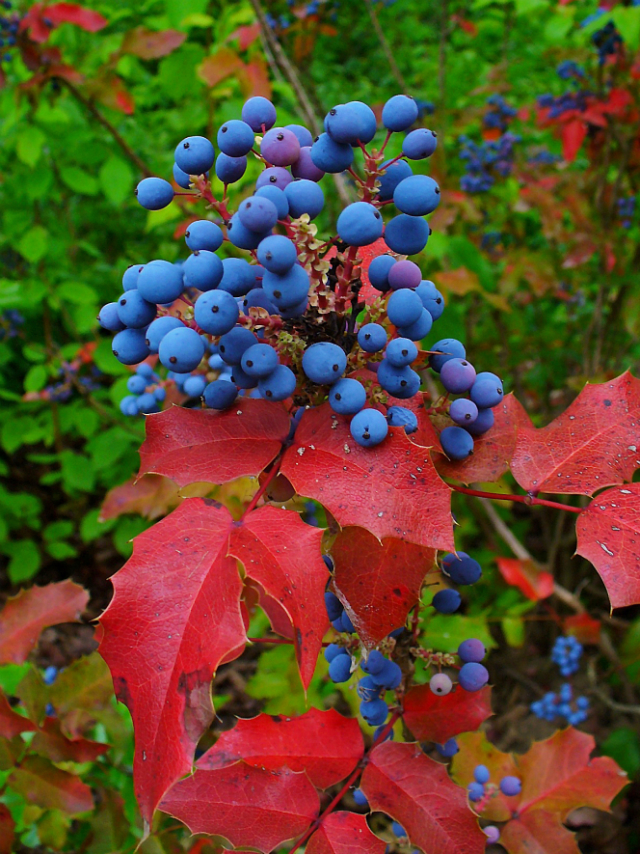
As the winter comes on some leaves temporarily lose their chlorophyl and become bright red.
The roots can be harvested at any time of the year but are ideally harvested in the fall or early spring.
Ethically Wildcrafting Oregon Grape Herb
Oregon grape root is being threatened with over-harvesting due, in part, to the florist business. Those green leaflets stay vibrant-looking long after they are picked, making them very desirable for arrangements. Keep an eye on your local plants and report any illegal harvesting that you see.
In part due to this, Oregon grape herb is on the United Plant Savers to watch list.
When harvesting Oregon grape root for your personal use, learn how to harvest it sustainably. Horizontal and somewhat superficial rhizomes can be sparingly harvested from the plant, leaving the remaining plant to grow.
How to Use Oregon Grape
We typically use the root or, if it is really woody, the root bark in herbal medicine.
When working with Oregon grape root make sure that your root or root bark is vibrant yellow! If it is no more than a cream color you really don’t have potent medicine. Unfortunately it can be hard to find really yellow roots in commerce, so I recommend harvesting your own (ethically!) or buying oregon grape root extract.
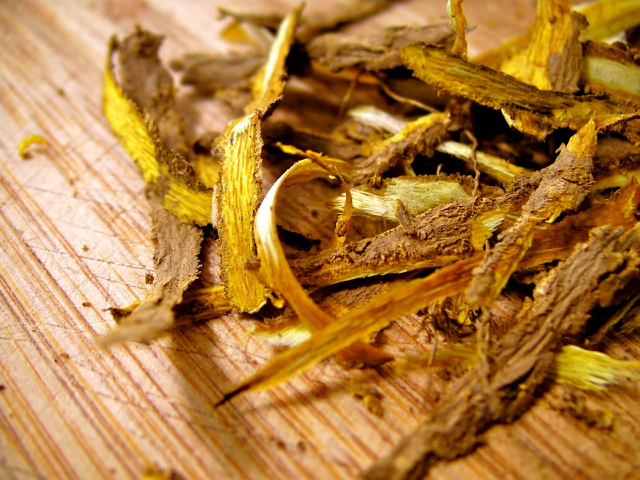
I also mostly use the Oregon grape root extract, mainly because it is so incredibly bitter it can be hard for people to drink oregon grape tea.
It does work as a tea, though. The tea also works great as an external wash.
Oregon grape root can be used as a dye.
It can also be infused into an oil and made into a salve. Darcey Williamson recommends it combined with willow bark for aches and pains.
Special Considerations
Oregon grape herb is not for the cold deficient type. There is some concern that it may interfere with some pharmaceutical drugs.
Summary of Oregon Grape Herb
Oregon grape root excels at treating infections and optimizing a sluggish liver. Its specific considerations are for heat with discharge or moist conditions. It is most often formulated, although it can be used as a simple, especially when used for infections. This is abundant and incredibly important herbal medicine.
This monograph was originally written for HerbMentor.com

Rosalee is an herbalist and author of the bestselling book Alchemy of Herbs: Transform Everyday Ingredients Into Foods & Remedies That Healand co-author of the bestselling book Wild Remedies: How to Forage Healing Foods and Craft Your Own Herbal Medicine. She's a registered herbalist with the American Herbalist Guild and has taught thousands of students through her online courses. Read about how Rosalee went from having a terminal illness to being a bestselling author in her full story here.
